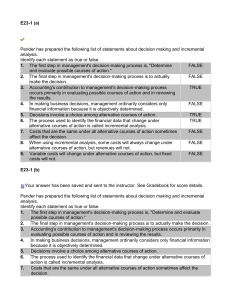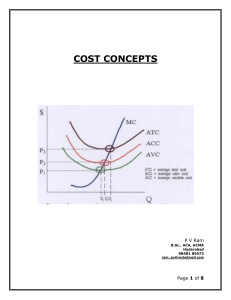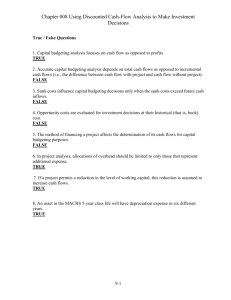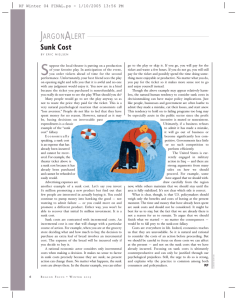Chapter 5 Solutions - Blackhall Publishing
advertisement
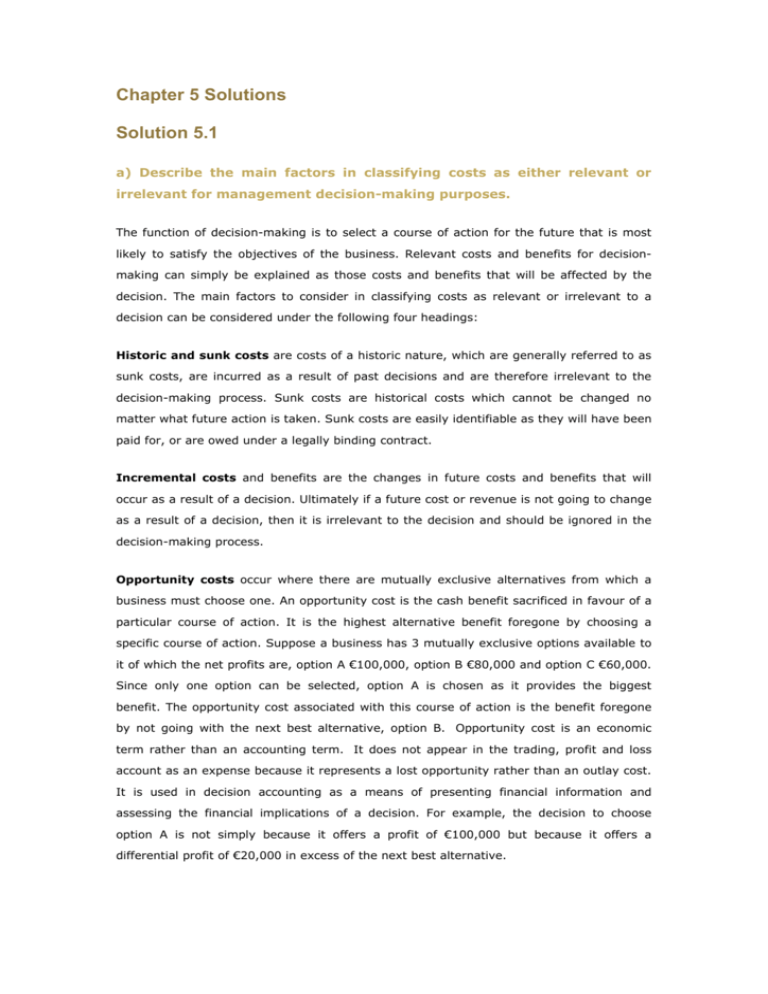
Chapter 5 Solutions Solution 5.1 a) Describe the main factors in classifying costs as either relevant or irrelevant for management decision-making purposes. The function of decision-making is to select a course of action for the future that is most likely to satisfy the objectives of the business. Relevant costs and benefits for decisionmaking can simply be explained as those costs and benefits that will be affected by the decision. The main factors to consider in classifying costs as relevant or irrelevant to a decision can be considered under the following four headings: Historic and sunk costs are costs of a historic nature, which are generally referred to as sunk costs, are incurred as a result of past decisions and are therefore irrelevant to the decision-making process. Sunk costs are historical costs which cannot be changed no matter what future action is taken. Sunk costs are easily identifiable as they will have been paid for, or are owed under a legally binding contract. Incremental costs and benefits are the changes in future costs and benefits that will occur as a result of a decision. Ultimately if a future cost or revenue is not going to change as a result of a decision, then it is irrelevant to the decision and should be ignored in the decision-making process. Opportunity costs occur where there are mutually exclusive alternatives from which a business must choose one. An opportunity cost is the cash benefit sacrificed in favour of a particular course of action. It is the highest alternative benefit foregone by choosing a specific course of action. Suppose a business has 3 mutually exclusive options available to it of which the net profits are, option A €100,000, option B €80,000 and option C €60,000. Since only one option can be selected, option A is chosen as it provides the biggest benefit. The opportunity cost associated with this course of action is the benefit foregone by not going with the next best alternative, option B. Opportunity cost is an economic term rather than an accounting term. It does not appear in the trading, profit and loss account as an expense because it represents a lost opportunity rather than an outlay cost. It is used in decision accounting as a means of presenting financial information and assessing the financial implications of a decision. For example, the decision to choose option A is not simply because it offers a profit of €100,000 but because it offers a differential profit of €20,000 in excess of the next best alternative. Replacement costs are relevant where an item or resource is purchased for a specific purpose other than the opportunity or decision under consideration. If the resource is used for this new opportunity then it will need to be replaced for its original purpose. The question is ‘what is the relevant cost for using the resource under the new opportunity?’ Is it the historic cost (what was originally paid for the resource), or is it the replacement cost (the cost of replacing the resource, as it was intended for another purpose)? The answer is the replacement cost. b) Depreciation is a significant element in the calculation of profit. Justify its classification as an irrelevant cost in decision-making. Depreciation is an expense relating to the purchase of fixed assets. The cost of fixed assets is an expense for a business and thus must appear in the profit and loss account. This is done through depreciation where the cost of the asset is charged against sales over the assets life. This is merely a bookkeeping transaction however as the assets has been purchased and paid for in the past. Thus depreciation is a sunk cost as it is related to the original cost of the asset. Question 5.2 Briefly explain the following financial terms and indicate their relevance in the context of short-term management decision-making Sunk costs are costs of a historic nature and are incurred as a result of past decisions and are therefore irrelevant to any decision-making process. Sunk costs are historical costs which cannot be changed no matter what future action is taken. Sunk costs are easily identifiable as they will have been paid for, or are owed under a legally binding contract. Incremental costs are the changes in future costs and that will occur as a result of a decision. Ultimately if a future cost or revenue is not going to change as a result of a decision, then it is irrelevant to the decision and should be ignored in the decision-making process. Unavoidable costs are costs that are non incremental and thus will not change as a result of a decision. Hence they are unavoidable and should not be considered in the decision-making process. For example a hotel is considering whether to take on a special offer from a travel agent who wants to pre-book rooms at a special discount price. The unavoidable costs in relation to this decision would be the fixed costs of the hotel as they would be very unlikely to change as a result of the decision. Thus they should be ignored in the decision-making process. Opportunity costs occur where there are mutually exclusive alternatives from which a business must choose one. An opportunity cost is the cash benefit sacrificed in favour of a particular course of action. It is the highest alternative benefit foregone by choosing a specific course of action. Suppose a business has 3 mutually exclusive options available to it of which the net profits are, option A €100,000, option B €80,000 and option C €60,000. Since only one option can be selected, option A is chosen as it provides the biggest benefit. The opportunity cost associated with this course of action is the benefit foregone by not going with the next best alternative, option B. Opportunity cost is an economic term rather than an accounting term. It does not appear in the trading, profit and loss account as an expense because it represents a lost opportunity rather than an outlay cost. It is used in decision accounting as a means of presenting financial information and assessing the financial implications of a decision. For example, the decision to choose option A is not simply because it offers a profit of €100,000 but because it offers a differential profit of €20,000 in excess of the next best alternative. Solution 5.3 a) Identify the incremental, sunk and unavoidable costs in the above scenario Incremental costs = Labour, supervision and materials. Unavoidable costs = Overhead charge b) Advise the company as to whether they should continue to manage their own cleaning or contract out the work This requires comparing the relevant costs and benefits of both options as follows. If the hotel does decide to out–source the work the additional revenues expected as a result of this decision can either be set off against the cost of outsourcing ( as done below) or added as an opportunity cost to the cost of the in-house option Labour Supervision Materials Cost of In House € 78,500 20,500 23,222 122,222 Add Opportunity gain Cost of Contract € 135,500 25,000 122,222 110,500 Based on the financials the business should go with the out-sourcing option. However management should be mindful of any non-financial factors which could sway the decision. For example factors such as 1. Re-deployment of the existing cleaners. 2. The effect of closure on staff morale. 3. Labour union objections. 4. Quality and reliability of the cleaning contractors. Question 5.4 Farley Chemist - upgrade of computer system Option A In-house modification Programmers (5 x €50,000) Technicians rise New technician VHI (on new staff only - 6 x €640) HR charge Computers (3 x €1,000) Printer Communications Desks 250,000 4,000 36,000 3,840 0 3,000 relevant cost €44,000 sunk cost relevant cost existing staff VHI is sunk cost sunk cost €900 x 2 is sunk cost 600 relevant cost 1,850 relevant cost 0 sunk cost Chairs (6 x €150) 900 relevant cost Technicians tools 180 relevant cost Consumables 500 relevant cost Admin. director Incremental cost of Option A 0 sunk cost 300,870 Option B Sub-contract Contract fee New employee VHI 300,000 relevant cost 56,000 relevant cost 640 relevant cost HR charge 0 sunk cost Computer 0 sunk cost Printer 600 relevant cost Desk 0 Chair 150 relevant cost 3,400 relevant cost Modems and coms equipment Admin. director Incremental cost of Option B 0 sunk cost sunk cost 360,790 I would advice Farley to adopt Option A from a financial viewpoint it incurs the lowest incremental cost. Question 5.5 a) Advise management on whether department B should remain open or closed explaining and justifying your view This question can be approached in two ways: 1. Focus on the incremental costs and revenues relating to the decision to close department B 2. Compare the overall profit of the business running including department B with the overall profit of the business excluding department B. Either approach should yield the same result. Taking the first approach the incremental costs and revenues associated with closing department B are as follows Dept B €'000 Revenues lost (160) Less Variable costs saved 100 Contribution lost (60) Less Fixed costs saved 30% x 80 24 (36) Additional revenues Net profit lost 5 (31) The business would be €31,000 worse off if it closed department B The second approach should give the same result. This requires the calculation of overall profit based on Department B closing. In this approach it is assumed that the non incremental fixed costs of department B are evenly divided between department A and C. A C Total €'000 €'000 €’000 320.0 240.0 560.0 2.5 2.5 5 322.5 242.5 565 Less Variable costs 120 140 260 Less Fixed costs 80 + (70% x 80/2) 108 108 216 Total cost 228 248 476 Net profit 94.5 (5.5) 89 Revenues Add additional revenue By comparing the overall profit including department B of €120,000 with the overall profit excluding department B of €89,000 it can be seen that the business is €31,000 worse off by closing department B b) Briefly outline the non-quantifiable factors that management should take into account before making a decision. Non-quantifiable or qualitative factors are best described as factors that cannot be quantified in terms of income and costs. In many respects some of the so called qualitative factors could be quantifiable in terms of their effects on the business but this quantification process would be very expensive and not worth the cost. The nature of qualitative factors in decision-making will almost always vary with the circumstances of the decision under review and the options under consideration. Regarding the above decision to close a department, management should be aware of the following qualitative factors, which should have an influence on the decision. The effect of closure on existing and potential customers - Management must assess the affects of closure on their customer base. For example, if customers feel goods and service provided by department B will not be available, that could influence their decision to purchase goods and services in the other departments. Ultimately the exclusion of one service from a range because, in financial terms, it is uneconomic to provide and sell, could affect the demand for other services. Services and products sold by firms are often inter-dependant and this should be taken into account in the decision-making process. The effect on employees and unions - Any decision regarding the closure of a section of a business needs to be accepted by employees and their unions. Bad labour relations caused by decisions that involve such changes can lead to poor morale, inefficiencies and losses. The reaction of competitors - How competitors will react to any changes should also be taken into account. For example if Home Stores reduced the variety of goods and services offered, this provides an opportunity for competitors to offer such goods and services and thus increasing their market share. Again management need to be mindful of the interdependence of products and how competitors will react to increase their market share The effect on suppliers - Closure decisions will affect suppliers and hence this relationship and their reaction must be taken into account in the decision-making process. Will closure of department B affect other supplies of goods and services. Will the business lose out on quantity discount and what effect will it have on the ability of suppliers to continue to supply the other departments. Question 5.6 Workings - apportion the head office charge and deduct from the overhead figure. Head Office Total Specific Finglas 500000÷2254x920 €204,082 €280,000 €75,918 Merrion 500000÷2254x736 €163,265 €220,000 €56,735 Baldoyle 500000÷2254x598 €132,653 €180,000 €47,437 €500,000 €180,000 a i) Marginal cost statement - original budget Finglas € Merrion € Baldoyle € Total € Rent receipts 920,000 736,000 598,000 2,254,000 Property upkeep 347,000 273,000 341,000 961,000 Wages and salaries 118,000 102,000 74,000 294,000 75,918 56,735 47,347 180,000 Total 540,918 431,735 462,347 1,435,000 'Site' profit 379,082 304,265 135,653 819,000 Overheads Head office 500,000 Net profit 319,000 a ii) Marginal cost statement - after closure of Baldoyle Finglas € Merrion € Total € Rent receipts 920,000 736,000 1,656,000 Property upkeep 347,000 273,000 620,000 Wages and salaries 118,000 102,000 220,000 75,918 56,735 132,653 540,918 431,735 972,653 379082 304265 683,347 Overheads Total 'Site' profit Head office 500,000 Net profit 183,347 b) Recommendation The Baldoyle complex should remain open. It is contributing €135,652 towards head office costs and profits. If it is closed the profit of the organisation will reduce by €135,653 from €319,000 to €183,347. Question 5.7 a) Identify the sunk, incremental and unavoidable costs in the above scenario a. Sunk costs – Original cost of the hotel b. Incremental costs – Variable costs c. Unavoidable costs – Fixed costs b) Advise Gerry and Debra whether or not they should take up the offer from the tour company. In this question the focus must be only on the incremental costs and revenues that occur as a result of a decision to accept or reject the order. If the business accepts the order the relevant costs and revenues are as follows. Incremental profit statement Incremental revenues 2,000 rooms @ €25 Incremental costs Incremental profit 2,000 rooms @ €20 € 50,000 40,000 10,000 By accepting the order the business will generate €10,000 extra profit. Gerry and Debra must be mindful of the qualitative factors that may affect this decision such as the dates when the tour operator will require the rooms. If this is during any peak business periods the business may lose out on existing sales. Also management need to be mindful of the fact that based on their normal price they would only need to sell and extra 500 bed-nights (€10,000 / 40-20) to achieve this extra €10,000 profit. This would amount to an occupancy level of 79%. Whether this is likely or not is debatable. Question 5.8 a) Viability of the proposal Profit calculation Sales € 2.50 Variable cost € 0.92 Contribution per unit € 1.58 Total contribution € 237,000 Fixed cost € 180,000 Profit Break-even point € 57,000 180,000 113,924 units € 284,810 revenue 36,076 units € 90,190 revenue 1.58 Margin of safety The proposal is viable. b) New proposal Volume (150,000x 115%) Contribution 172,500 € 1.33 New contribution €229,425 Fixed cost €180,000 Profit € 49,425 Break-even point 135,338 units (drop of €7,575 ) (increase of 21,414 units) c) Recommendation Yes, the fresh bread proposal should be adopted but not with the free cup of tea. d) Other factors to consider: • Would the image of the outlet be affected? • Better service to existing customers or potential to attract new customers? • Would sales of prebaked bread be affected by the fresh baked bread? • Are the staff experience enough? • Can staff cope with the additional work? • Are there health and safety considerations? • Are there legal concerns that need to be addressed? Question 5.9 Staff crèche proposal Financial Analysis Revenue Rent Opportunity cost Insurance € 150,000 incremental € 0 sunk cost - € 30,000 profit forgone - € 8,000 incremental cost Child care workers - € 50,000 specific cost Assistants - € 40,000 specific cost Overheads € 0 sunk cost Retail park manager € 0 sunk cost Essential materials - € 2,000 incremental cost Surplus € 20,000 As the proposal provides a surplus of €20,000 it is financially viable and from a financial viewpoint should be encouraged / adopted. Question 5.10 Advise management on whether the hotel should remain open or closed during the off-season. You should justify your recommendation The question can be approached in two ways 1. Calculate the profit of the hotel if it closed during the off-season and compare this to the profit if the company stayed open all year round. 2. Focus on the incremental changes to costs and revenues based on closing the hotel in the off-season and base the decision on whether the incremental benefits exceed the incremental costs Both approaches are shown below. Approach 1 Approach 2 Incremental Open Season Open 12 costs and only months revenues € € € 500,365 588,815 88,450 COGS 210,153.3 247,302.3 37,149 W&S 93,500 104,700 11,200 Caretakers wages 10,000 Sales Less variable costs -10,000 LHP 7,850 13,528 5,678 R and M 6,670 8,290 1,620 Advertising 2,468 3,924 1,456 Staff meals 6,800 11,100 4,300 Telephone 8,870 11,450 2,580 2,500 4,500 2,000 348,811 404,794 Sundry expenses Contribution 151,554 184,021 55,983 32,467 The hotel is €28,467 more profitable due to being open for the full year and thus should remain open for the full period. Question 5.10 Selling price MDA agreed with the bakery Establish unit costs Per unit Sales € 1.40 Variable cost (€1.40 x 45%) € 0.63 Contribution (€1.40 x 55%) € 0.77 Fixed cost (€1.40 x 25%) € 0.35 Profit (€1.40 x 30%) € 0.42 Check capacity to establish the opportunity cost Current capacity 500,000 Full 625,000 Want 650,000 Short 25,000 Establish contribution per unit Sales € 1.40 Variable cost € 0.63 Contribution € 0.77 Opportunity cost (25,000 x €0.77) € 19,250 Establish the selling price by including, opportunity cost, additional costs and agreed profit. Opportunity cost (25,000 loaves x 0.77) € 19,250 Extra fixed cost € 30,000 Total extra costs € 49,250 Total number of units to share these costs 150,000 Extra costs per unit (49,250/150,000) € 0.33 Variable costs € 0.63 Agreed profit € 0.20 Selling price € 1.16 Qualitative issues to be considered by a retailer considering 'private label' items • Will the image of the outlet be affected? as private label can be considered inferior by some customers. • Will sales of branded items be affected? • Will staff be able to cope with the strategy on a day to day basis? • The quality of the products produced by the bakery in the retailers name. • The reliability of the bakery. • Will new customers be attracted to the store? Question 5.12 a) State whether each of the above is relevant or irrelevant to the decision to accept this order. Materials The relevant cost for material A is its purchase price of €20,000. Material B is already in stock and thus its original costs is a suck cost and its irrelevant to the decision. However by using material B we forego the necessity of disposing of this material at a cost of €1,500. This cost saving is relevant to the decision. Labour costs The direct labour costs is relevant to the decision. The specialist labour costs of €10,000 is irrelevant as this is provided by in-house staff. However they will need to be replaced and this replacement cost is relevant to the decision. Thus the €13,000 replacement cost of labour is relevant to the decision. Foreman’s salary The existing salary does not change as a result of the decision and thus it is irrelevant. Machinery The original cost and net book value of the machinery is irrelevant to the decision as it is a sunk cost. However as a direct result of using the machinery on the job the business will not be able to sell the machinery and this will result in a reduction in future cash flows of €10,000 (€15,000 - €5,000) Overheads These costs are non-incremental and thus are irrelevant to the decision b) Recommend to the company, based on quantitative information, whether the company should accept this order based on the agreed price of €100,000. € Incremental revenue € 100,000 Less incremental costs Material A 20,000 Material B (cost saving) (1,500) Direct labour 25,000 Specialist labour 13,000 Machinery 10,000 Incremental profit 66,500 33,500 As the project shows a profit the company should accept the order unless there are better opportunities available, or non-quantifiable factors exist, that would indicate otherwise.

